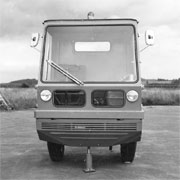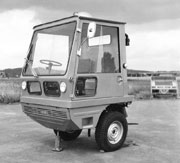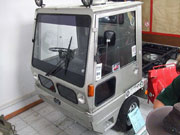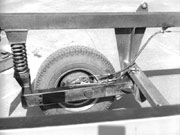|
|
 |
Triebkopf

|
The Steyr Puch Triebkopf is closely related with the Haflinger. The basic idea was to have a universal front end that could be connected to
any rear or front carriage (yes, also front carriage was possible - see below). The Triebkopf was introduced in 1971, when more and more
Kommunalhaflingers were sold. Picture: Archive Dr. Rudolf.
Der Steyr Puch Triebkopf ist eng verwandt mit dem Haflinger. Die Idee war, einen universellen Triebkopf zu schaffen, der mit verschiedensten
Nachläfern oder "Vorläufern" (siehe weiter unten) kombiniert werden kann. Der Triebkopf wurde 1971 präsentiert,
als auch mehr und mehr Kommunalhaflinger verkauft wurden.
|

|
The Triebkopf consists of a steerable axle that also includes the gearbox. A Haflinger engine is mounted in front of the axle (180 degrees turned
compared to the Haflinger). A cabin is mounted above the chassis. In this picture you can also see a decoupled rear carriage. Picture: Archive
Dr. Rudolf.
Der Triebkopf besteht aus einer lenkbaren Achse, die auch das Getriebe beinhaltet, sowie aus einem Haflinger-Motor, der um 180 Grad
gedreht vor der Achse angeflanscht ist. Auf dem Fahrgestell ist ein Führerhaus aufgesetzt. In diesem Bild sieht man auch einen
abgekoppelten Nachläfer.
|

|
A rear carriage could be coupled (or welded) to the Triebkopf. It was Steyr Puch's idea that the rear carriage could also be manufactured by
a third-party company. The rear wheels with brakes were provided by Steyr Puch. Picture: Archive Dr. Rudolf.
Ein Nachläfer konnte am Triebkopf angekoppelt oder angeschweißt werden. Der Nachläfer sollte auch von Drittfirmen
entwickelt und gefertigt werden können. Die Hinterräder (mit Bremsen) wurden von Steyr Puch zur Verfügung gestellt.
|

|
The Triebkopf axle is very similar to the Haflinger axles. It is more or less a combination of the Haflinger front and rear axles: It has a
gearbox and is steerable. It also has the Haflinger's hubs for higher ground clearance. The differential is lockable. Picture: Archive Dr. Rudolf.
Die Achse des Triebkopfs ist mehr oder weniger eine Kombination der Haflinger Vorder- und Hinterachsen: Das Getriebe ist integriert und
sie ist lenkbar. Die Portalbauweise für mehr Bodenfreiheit ist ebenfalls vom Haflinger übernommen. Das Differential ist sperrbar.
|

|
I know this is a poor picture, but I don't have it in better quality. It shows some possible Triebkopf options. Note that there was also
a front carriage available for the Triebkopf, but I am not sure about the application (maybe for discharging waste containers).
Leider habe ich dieses Bild nur in schlechter Qualität. Es zeigt einige mögliche Triebkopfvarianten. Man beachte, dass
es auch einen "Vorläufer" gab, bei dem der Triebkopf die Hinterachse darstellte (wahrscheinlich für die Entleerung
von Mülltonnen o.Ä.).
|

|
This Triebkopf was shown at the 50 Years Haflinger anniversary at Stiefern/Kamptal in 2009. It was also shown ten years before in 1999 at
the 40 Years anniversary at Graz. It now belongs to an Austrian Steyr Puch parts dealer.
Dieser Triebkopf war beim 50 Jahre Haflinger Treffen in Stiefern im Kamptal ausgestellt (und auch schon 10 Jahre davor beim Treffen in
Graz).
|

|
In this case, the rear carriage is welded to the Triebkopf. Sadly, I don't know who made the rear carriage.
In diesem Fall ist der Nachläufer mit dem Triebkopf verschweißt. Leider weiß ich nicht, wer den Nachläufer
konstruiert hat.
|

|
Note that the fuel tank is mounted on the rear frame while on the archive pictures above, the fuel tank is inside the cabin where the
passenger seat would normally be (completely independent from the rear carriage design).
Der Tank ist hier am Rahmen montiert, während der Tank beim Fahrzeug weiter oben in der Kabine sitzt (Unabhängigkeit
vom Nachläfer).
|

|
Here you see the rear axle. Note that there is a double conduit exhaust system fitted instead of the oval Haflinger silencer.
Hier sieht man die Hinterachse. Man beachte, dass ein doppelrohriger Abgasstrang montiert ist (anstatt des Haflinger-Schalldämpfers,
wie oben abgebildet).
|
Earlier Version Triebkopf

|
What you see here is possibly an earlier "Prototype" Triebkopf. The cabin style and the interior is different from the
model shown above, while the chassis appears to be mostly the same. This and the following pictures: Steyr-Daimler-Puch
Archive AQ.
Hier ist wahrscheinlich ein Triebkopf Prototyp zu sehen. Das Fahrerhaus und die Innenausstattung ist noch etwas anders als
beim oben gezeigten Modell, das Fahrgestell scheint jedoch ziemlich gleich aufgebaut zu sein.
|

|
This vehicle is also shown in a german
Haflinger/Triebkopf brochure.
Dieses Fahrzeug ist auch in einem deutschen Haflinger/Triebkopf Prospekt abgebildet.
|

|
|

|
Note that in this picture, there is more or less no equipment fitted to the vehicle...
In diesem Bild ist das Fahrzeug noch eher roh...
|

|
...while in this picture, the Triebkopf has rear lights, mud guards, number plate holder, brake lines and cables as well as an exhaust
pipe and an air intake filter.
...wärend in diesem Foto schon Rücklichter, Kotbleche, Kennzeichenhalterung, Bremsschläche und -seile sowie
ein Auspuffrohr und ein Luftfilter zu sehen sind.
|

|
|

|
Here you can see well the front mounted engine. Note the steep fan blades, which were also common on Kommunalhaflingers.
Hier sieht man schön den vorne angeflanschten Motor. Die steilen Flügel am Lüfterrad waren auch bei Kommunalhaflingern üblich.
|

|
|

|
It seems that the half axles were changed from the "fork-style" to a different design... I don't know exactly how the half axles are
connected to the differential/gearbox housing.
Es scheint, dass die Halbachsen nicht mehr "gabelförmig" ausgeführt wurden. Leider kann ich nicht genau sagen,
wie die Halbachsen mit dem Differential- bzw. Getriebegehäuse verbunden sind.
|

|
Interior with engine room and Eberspächer heater.
Inneneinrichtung mit Motorraum und Eberspächer Heizung.
|

|
Here you see the rear section of the chassis and how it is connected to the body frame.
Hier sieht man den hinteren Teil des Fahrgestells und die Verbindung zum Rahmen der Karosserie.
|

|
Also note the handbrake cable that goes to the rear wheels.
Man beachte auch den Handbremsseilzug, der zu den hinteren Rädern geht.
|

|
It appears that there are also Haflinger hub gear casings used for the rear wheels, but they are welded to the cross member in an angled
position. Possibly there are no hub gear wheels inside.
Es scheint als wären die hinteren Portalantriebsgehäse vom Haflinger übernommen, jedoch sind sie schräg
mit dem Achsträger verschweißt. Wahrscheinlich sind innen keine Zahnräder verbaut.
|
Links
|
Steyr Puch Triebkopf owner's manual |

|
|
Steyr Puch Triebkopf brochure |

|
Comments
Here is, where your part of the page begins! If you have anything to contribute, feel free to
add a comment!
At the moment, there exist no comments for this page yet.
|









